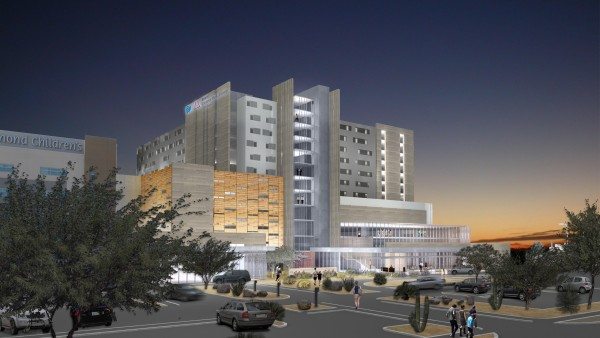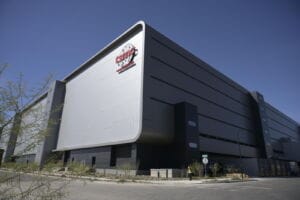If you want to build it, they will come.
Healthcare contractors have been champing at the bit for the last year in anticipation of two major hospital projects in Arizona. In November 2014, Prop 480 passed, which would enable a replacement of the largest clinical teaching hospital in Maricopa County, Maricopa Integrated Health Systems (MIHS), and to develop additional facilities on the campus.
In January, Banner Health finalized its acquisition of the University of Arizona Health Network, which includes the medical school and its facilities. The terms of the affiliation included an agreement to invest $500M over five years into the community. So far, the plans include a new patient tower at the existing campus and a new hospital on the north campus.
“We started with what was the former owner’s priorities and tore into those assumptions and concluded that instead of upgrades on the campus, it was going to require a replacement of the patient care tower,” says Kathy Bollinger, executive vice president of academic delivery for Banner Health.
The current University of Arizona Medical Campus’ operating rooms are the same size as those built 40 years ago — 350 SF. Now, operating rooms are twice the size, Bollinger explains. Building a new facility will cost more, though considerably less than completely retrofitting the entire campus, she adds. Patients of the existing facility need somewhere to go. That’s where the new comes in.
“From a timing standpoint, things must move out before we begin the hospital project,” Bollinger adds. The RFP for general contractors on the new hospital facility, Banner-University Medical Center Tucson, were issued in late March with a selection expected to be made May 1.
“I’ll be thrilled if we get a shovel in the ground this year,” says Bollinger, adding that it’s more likely to happen in early 2016.
However, for the last year, general contractors have had their eyes on Tucson and preparing strategic partnerships (some are admittedly going solo) in anticipation of the RFP and work.
“A key criteria for the selection will include the ability to include Tucson-based sub-contractors in the project,” says Kip Edwards, vice president of development and construction for Banner Health.
Banner Health solicits from a pre-approved general contractor list, meaning it works with firms it’s familiar with. Edwards had only heard of one joint venture prior to releasing the RFP.

“There are not generals large enough in the Tucson market to do a hospital project of this magnitude,” he says. “One of our big focuses will be their inclusion of Tucson-based subs. They’ll have to demonstrate their knowledge of the Tucson market.”
This is why DPR Construction tapped Tucson-based Sundt Construction for a joint venture on the project. In addition to a history of joint ventures on educational life science facilities between the two companies, DPR aligned itself with the company for the local know-how.
“I think Banner will get a lot of pressure from the local Tucson marketplace to use as many Tucsonians as possible,” says Hamilton Espinosa, national healthcare leader for DPR Construction. “I think the Tucson community is very proud.”
Ryan Abbott, science and technology group leader for Sundt Construction, observes that using local subcontractors does bring more pride into a project.
“We find that we get a lot more pride in craftsmanship if (subcontractors) drive by that project and can tell family they did that,” he says. “A project built by a community that will benefit from the project, there’s a natural alignment of behavior there…Our industry is really complex and aggregates thousands of supply chains. The simpler you can make those by being locally sourced, the better you are at providing a predictable outcome.”
Sundt Construction is also a prolific joint venturer.
“Most of the time we form a joint venture, it’s not because of the scale of the project,” says Abbott, adding that there can never be too many different experts at work.
It’s about knowing the owner, adds McCarthy Building Companies’ Executive Vice President Justin Kelton.
“McCarthy has a bonding capacity so that we don’t really need a partner (on the MIHS project), but we listen to our owners,” he says. “Either one of us could do the job alone or on our own,” he adds of joint venture partner DPR Construction for the MIHS project. “On Maricopa, you make some assumptions that in public work we can bring a lot to the table as a team. I think they would be more comfortable (with a team).”
Though an RFP for the MIHS project may be a year or more away, one general contractor suggests, these partnerships all started being discussed more than a year ago. Kitchell’s Russ Korcuska said talks of joint ventures for the Maricopa project started about two years ago and more formally a year ago. Currently, it has a loose joint venture with Hunt Construction but nothing finalized by press time.
“These investments are understood to be tremendous opportunities for our community,” says MIHS CEO Steve Purves of the enthusiasm. “In addition to the construction jobs that will be created by the capital projects, the economic impact of what MIHS does – advanced patient care, medical education and clinical training – is quite economically significant to Maricopa County and the State of Arizona.”
As for insight into when general contractors can expect an RFP, Purves isn’t particularly specific.
“Since the election last November, the district board has been meeting regularly to discuss how best to approach the work ahead, ever mindful of its stewardship role regarding this voter-approved bonding capacity,” he says. “The board is looking at best practices and studying integrated project management approaches to prepare for managing the numerous projects and commercial partners in a highly organized and collaborative environment.”
Prop 480 describes three types of projects: outpatient, behavioral and acute care facilities.
“The projects within these three buckets will compromise a substantial portfolio of projects,” Purves says. “It can be a bit daunting to think about them all.”
In the meantime, the district board will work on a timeline “for the proper staging of a project portfolio of this magnitude,” Purves says. He suggested those who are interested in the contract procurement process register at the district’s website to join an email list.





